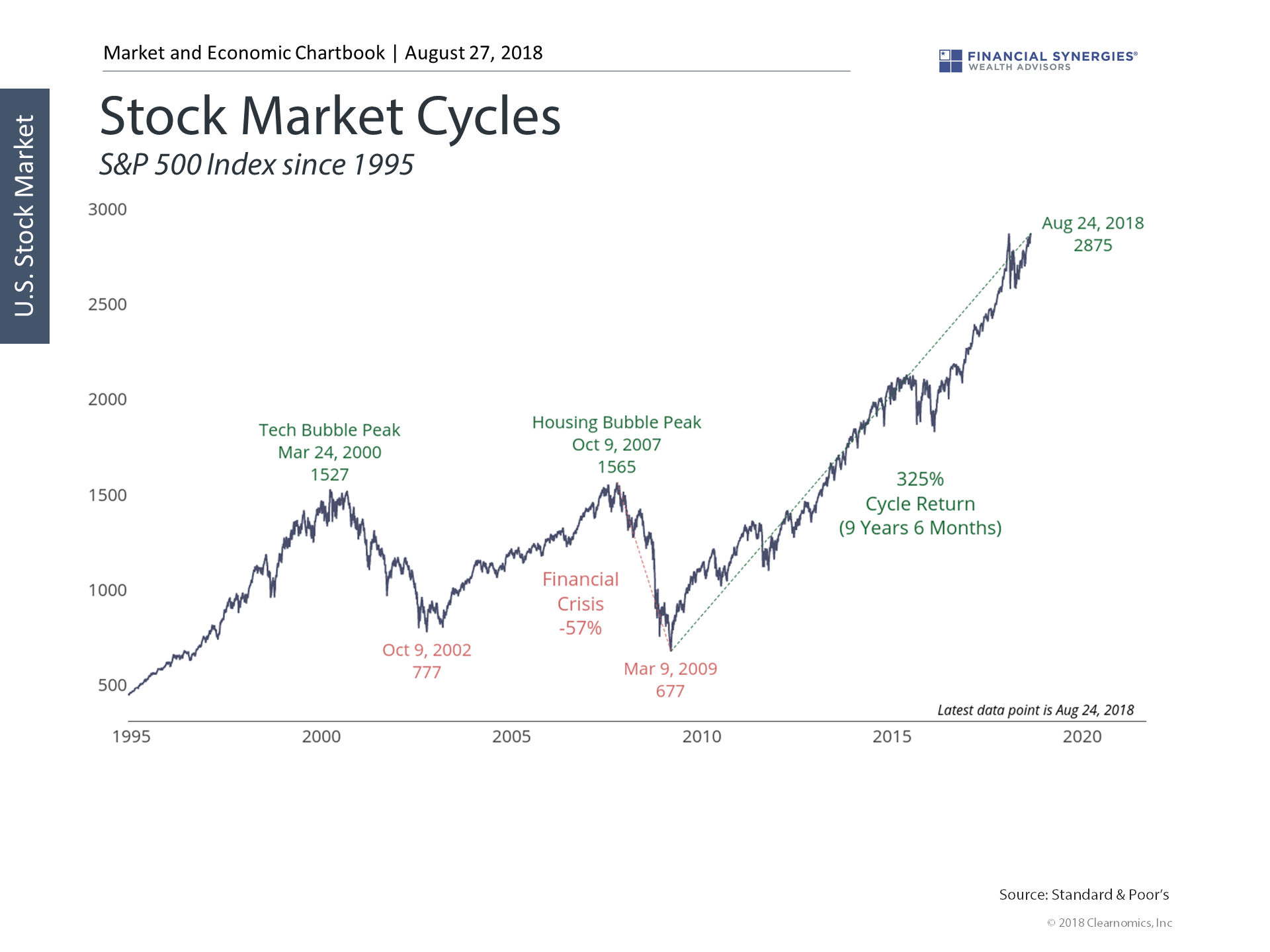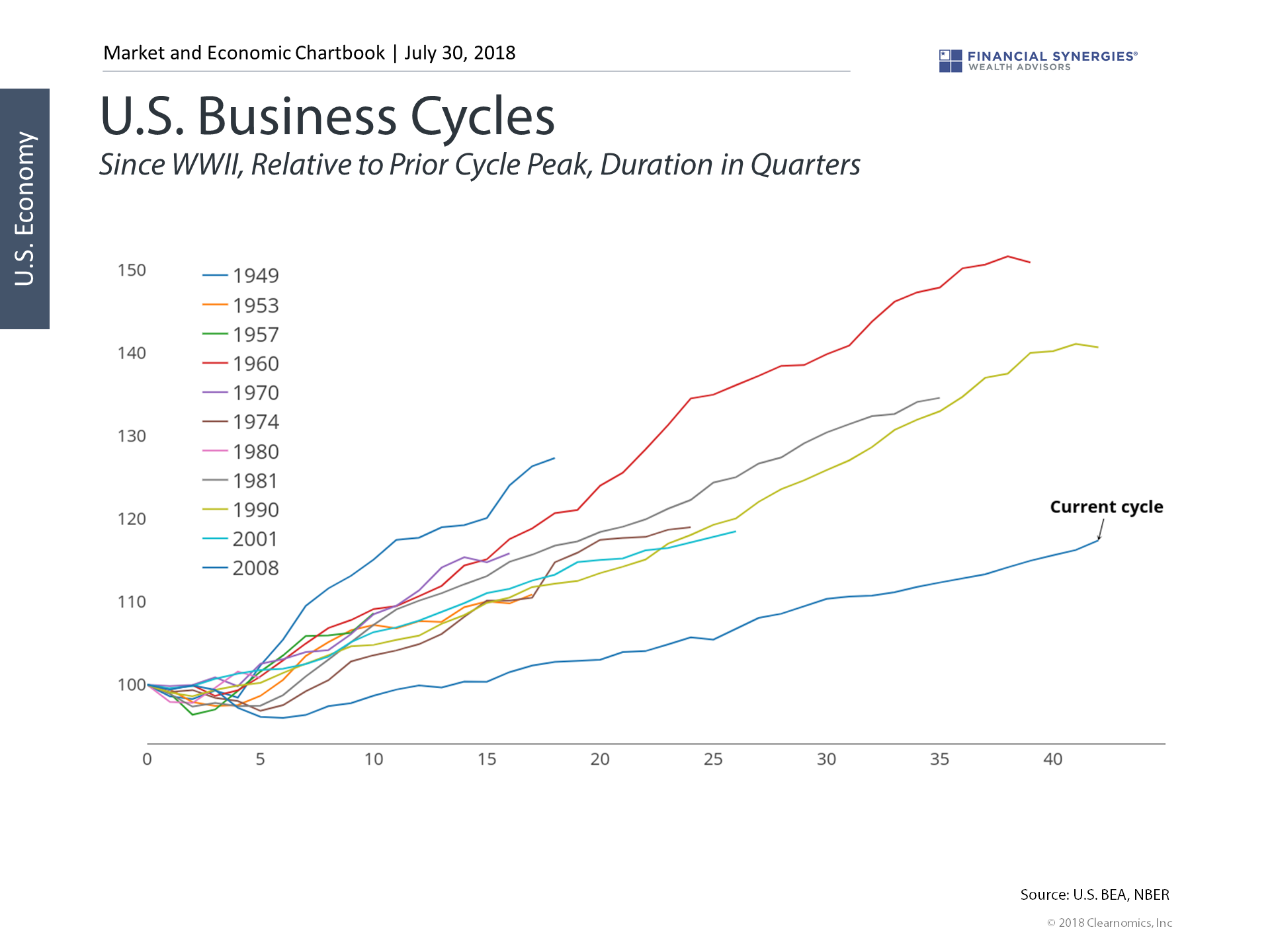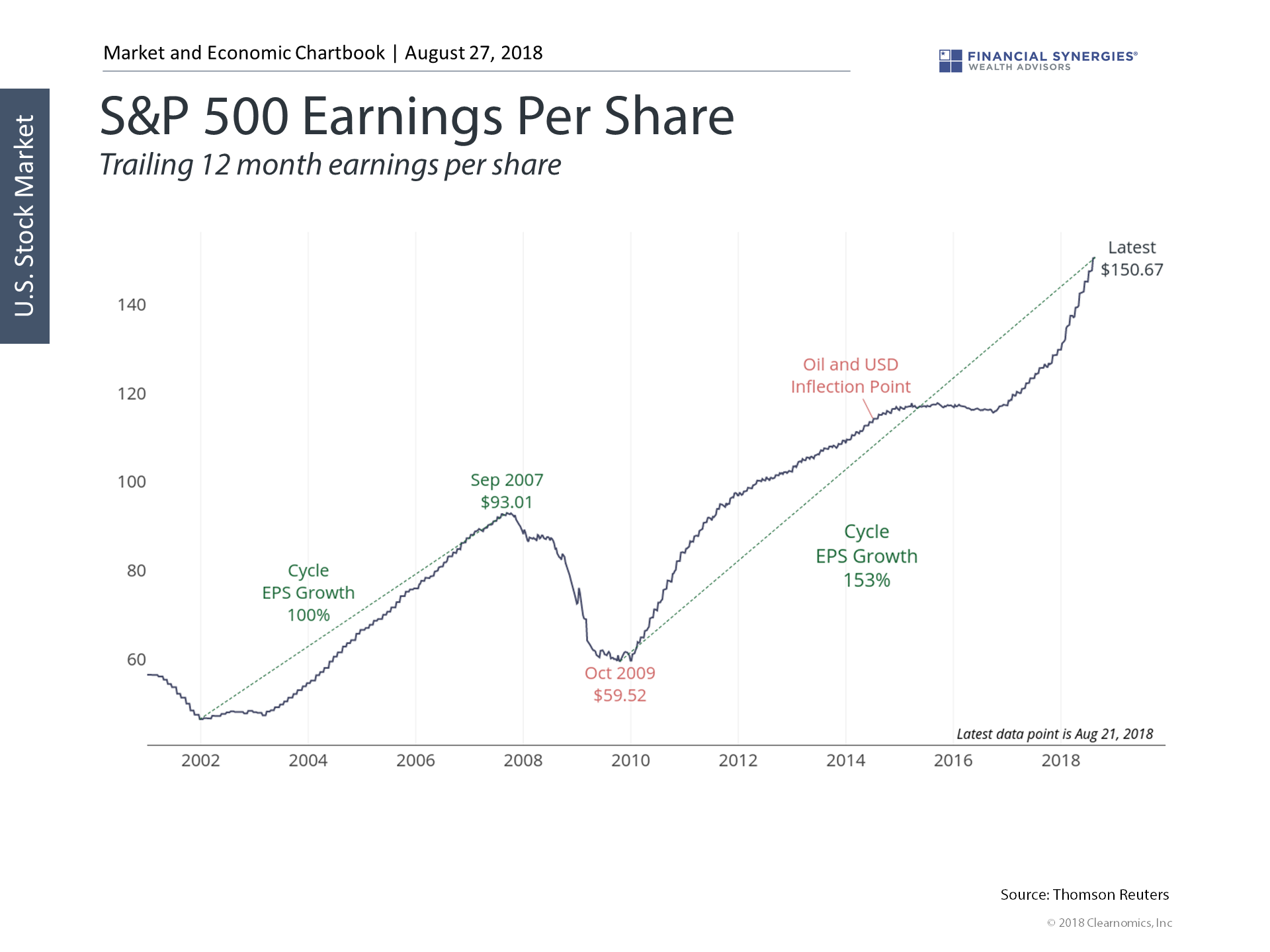The current bull market is now officially the longest on record, surpassing the 1990’s bull run. Over the past nine and a half years, the S&P 500 index has risen 325%, the Dow Jones Industrial Average 294%, and the NASDAQ Composite 526%.
While this significant milestone has received much press coverage, market cycles don’t operate on a schedule. Over time, the real key to sustainable market rallies is economic growth. It’s no coincidence that this is also one of the longest economic expansions on record, although still nine months shy of eclipsing the 1990’s. With this backdrop, corporate earnings-per-share have grown by over 150% since 2009, boosting stock prices across sectors.
And while the S&P 500 has also reached new all-time highs, giving some investors a sense of vertigo, price isn’t the right measure by which to judge the attractiveness of stocks. The importance of valuations is that they tell us what we’re getting for that price. At a 16.5x price-to-earnings multiple, investors are paying $16.50 today for every dollar of next year’s earnings. While this may not sound cheap, it’s also not extreme (the tech bubble peaked at 24.5x).
Looking forward, earnings could continue to grow as economic growth continues, and valuations could continue to rise as global issues such as trade are resolved. At the same time, volatility should also remain high as the cycle matures, making it more important to withstand short-term bumps like the ones experienced this year.
Perhaps most importantly, is to remind ourselves that disciplined long-term investing isn’t about timing the stock market. Rather, it’s about constructing well-balanced portfolios that can weather all types of market environments.
1. This is now the longest bull market on record

The U.S. market has led the global recovery since 2009, returning 325%. The mantra of holding stocks for the long run has truly benefited investors who stayed invested and disciplined. As always, the question isn’t whether to be in or out of stocks – it’s how much to allocate within a diversified portfolio.
While global markets have stumbled this year, many of the economic fundamentals that resulted in this historic rally are still healthy. It’s often said that market cycles don’t have an expiration date. As long as underlying growth is likely to continue, long-term investors can still find attractive returns in holding a balanced portfolio of stocks and bonds.
2. It’s no coincidence that this is also one of the longest economic expansions on record
 The chart above shows the path of economic growth during the eleven recessions and subsequent expansions since World War II, with the level of GDP re-indexed to 100 and length measured in quarters. We can easily see that the ten-year cycle during the 1990’s witnessed the economy grow three times more than the current cycle.
The chart above shows the path of economic growth during the eleven recessions and subsequent expansions since World War II, with the level of GDP re-indexed to 100 and length measured in quarters. We can easily see that the ten-year cycle during the 1990’s witnessed the economy grow three times more than the current cycle.
However, it’s not just about the sheer pace of growth – the fact that growth has been steady has been enough to push unemployment to historically low levels and generate strong corporate profits, pushing stocks to record highs.
3. Healthy economic growth and earnings have driven this bull market
 Healthy corporate earnings have supported strong market returns. U.S. companies are doing well due to solid global growth, still-low interest rates, and trends that support healthy profit margins. Looking forward, the earnings of S&P 500 companies are expected to grow 13% over the next year.
Healthy corporate earnings have supported strong market returns. U.S. companies are doing well due to solid global growth, still-low interest rates, and trends that support healthy profit margins. Looking forward, the earnings of S&P 500 companies are expected to grow 13% over the next year.
Over this market cycle, corporate earnings have risen by 153%, a key reason for the strong returns to stocks over this period. Thus, while there are short-term concerns driving markets, investors can maintain optimism over the long run if this earnings trajectory continues.
4. It’s importance to stay disciplined

We rebalance our clients’ portfolios regularly to maintain an optimal asset allocation. This is because, over time, portfolios naturally “drift” due to the performance of different asset classes. We don’t base our rebalancing decisions on a time frame (e.g. every six months, or annually on January 15th). Rather, we have strict tolerance levels around each unique asset class, and when they drift out of balance, we place trades to optimize the portfolio.
For instance, the chart above depicts what would have happened to different portfolio allocations without regular rebalancing since 2009. During this period, an investor who didn’t rebalance would have found their stock allocation increase as a percentage of their overall portfolio. The resulting mix would be less and less appropriate for that investor over time. Rebalancing regularly helps to ensure that your asset allocation continues to fit your goals and risk tolerance.
Is all this cause for concern?
It’s natural for investors to have concerns when they hear, “this is now the longest bull market in history.” Certainly there are those that say this can’t go on much longer, so let’s get out while we’re ahead. It’s just not that simple. Nobody (this includes professional investors and amateur investors) can predict the stock market’s movements.
Mr. Market will make you regret your timing decisions more often than not.
We need look no further than those who have been sitting in cash since 2008-2009 waiting for a good time to re-enter the market. Meanwhile they’ve missed the most historic market run in history. There are huge opportunity costs to the investment decisions we make.
Please don’t think I’m attempting to demean anyone who cashed out during the crisis, never to return. I absolutely understand where they were coming from. We had countless conversations with clients during the Financial Crisis that centered around this very subject. Honestly, I was scared out of my mind. I had never experienced anything like that, and I started my investing career right before the Tech Crash in 2000.
But that experience taught me more about investing and market cycles than anything I could ever learn in school or books. Conviction is everything. Sure, this bull market may end next year, or the year after, or the year after that. And eventually we’ll go through another recession, and then another economic recovery. Nobody knows when this will occur.
What we can be reasonably sure of is that global stock markets, through all the ups and downs, will trend higher and higher over the long run. This is why we invest.
Source: Clearnomics
The Longest Bull Market in History
The current bull market is now officially the longest on record, surpassing the 1990’s bull run. Over the past nine and a half years, the S&P 500 index has risen 325%, the Dow Jones Industrial Average 294%, and the NASDAQ Composite 526%.
While this significant milestone has received much press coverage, market cycles don’t operate on a schedule. Over time, the real key to sustainable market rallies is economic growth. It’s no coincidence that this is also one of the longest economic expansions on record, although still nine months shy of eclipsing the 1990’s. With this backdrop, corporate earnings-per-share have grown by over 150% since 2009, boosting stock prices across sectors.
And while the S&P 500 has also reached new all-time highs, giving some investors a sense of vertigo, price isn’t the right measure by which to judge the attractiveness of stocks. The importance of valuations is that they tell us what we’re getting for that price. At a 16.5x price-to-earnings multiple, investors are paying $16.50 today for every dollar of next year’s earnings. While this may not sound cheap, it’s also not extreme (the tech bubble peaked at 24.5x).
Looking forward, earnings could continue to grow as economic growth continues, and valuations could continue to rise as global issues such as trade are resolved. At the same time, volatility should also remain high as the cycle matures, making it more important to withstand short-term bumps like the ones experienced this year.
Perhaps most importantly, is to remind ourselves that disciplined long-term investing isn’t about timing the stock market. Rather, it’s about constructing well-balanced portfolios that can weather all types of market environments.
1. This is now the longest bull market on record
The U.S. market has led the global recovery since 2009, returning 325%. The mantra of holding stocks for the long run has truly benefited investors who stayed invested and disciplined. As always, the question isn’t whether to be in or out of stocks – it’s how much to allocate within a diversified portfolio.
While global markets have stumbled this year, many of the economic fundamentals that resulted in this historic rally are still healthy. It’s often said that market cycles don’t have an expiration date. As long as underlying growth is likely to continue, long-term investors can still find attractive returns in holding a balanced portfolio of stocks and bonds.
2. It’s no coincidence that this is also one of the longest economic expansions on record
However, it’s not just about the sheer pace of growth – the fact that growth has been steady has been enough to push unemployment to historically low levels and generate strong corporate profits, pushing stocks to record highs.
3. Healthy economic growth and earnings have driven this bull market
Over this market cycle, corporate earnings have risen by 153%, a key reason for the strong returns to stocks over this period. Thus, while there are short-term concerns driving markets, investors can maintain optimism over the long run if this earnings trajectory continues.
4. It’s importance to stay disciplined
We rebalance our clients’ portfolios regularly to maintain an optimal asset allocation. This is because, over time, portfolios naturally “drift” due to the performance of different asset classes. We don’t base our rebalancing decisions on a time frame (e.g. every six months, or annually on January 15th). Rather, we have strict tolerance levels around each unique asset class, and when they drift out of balance, we place trades to optimize the portfolio.
For instance, the chart above depicts what would have happened to different portfolio allocations without regular rebalancing since 2009. During this period, an investor who didn’t rebalance would have found their stock allocation increase as a percentage of their overall portfolio. The resulting mix would be less and less appropriate for that investor over time. Rebalancing regularly helps to ensure that your asset allocation continues to fit your goals and risk tolerance.
Is all this cause for concern?
It’s natural for investors to have concerns when they hear, “this is now the longest bull market in history.” Certainly there are those that say this can’t go on much longer, so let’s get out while we’re ahead. It’s just not that simple. Nobody (this includes professional investors and amateur investors) can predict the stock market’s movements.
We need look no further than those who have been sitting in cash since 2008-2009 waiting for a good time to re-enter the market. Meanwhile they’ve missed the most historic market run in history. There are huge opportunity costs to the investment decisions we make.
Please don’t think I’m attempting to demean anyone who cashed out during the crisis, never to return. I absolutely understand where they were coming from. We had countless conversations with clients during the Financial Crisis that centered around this very subject. Honestly, I was scared out of my mind. I had never experienced anything like that, and I started my investing career right before the Tech Crash in 2000.
But that experience taught me more about investing and market cycles than anything I could ever learn in school or books. Conviction is everything. Sure, this bull market may end next year, or the year after, or the year after that. And eventually we’ll go through another recession, and then another economic recovery. Nobody knows when this will occur.
What we can be reasonably sure of is that global stock markets, through all the ups and downs, will trend higher and higher over the long run. This is why we invest.
Source: Clearnomics
Recent Posts
Should You Fear Market All-Time Highs?
Last Week on Wall Street: Trade and Jobs Cheer Markets [July 7-2025]
2nd Quarter 2025 Market and Economic Review
Subscribe to Our Blog
Shareholder | Chief Investment Officer